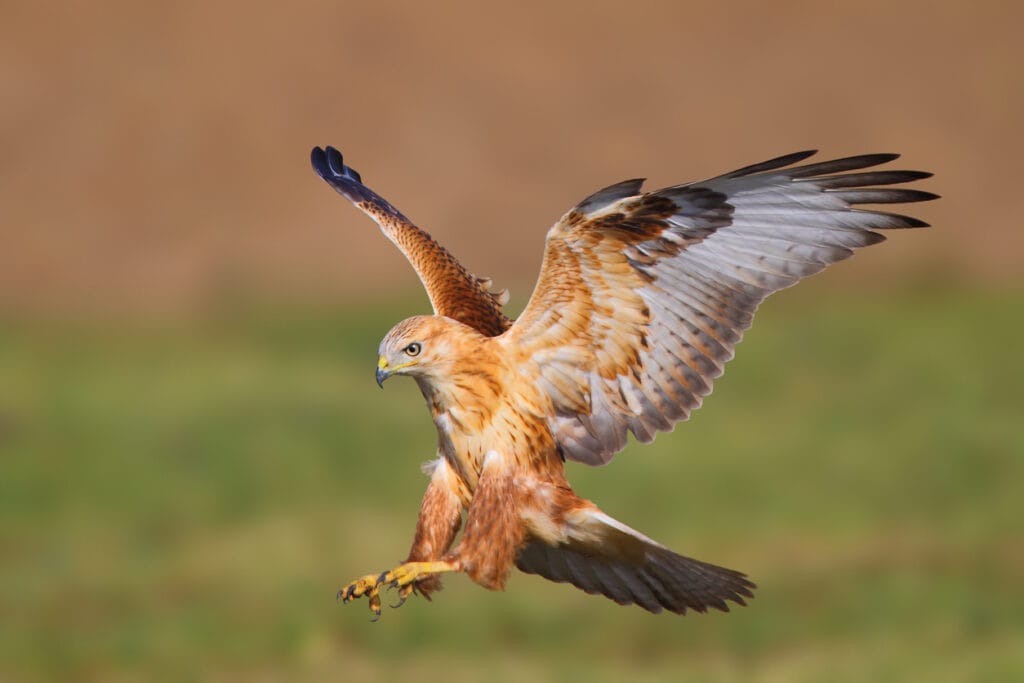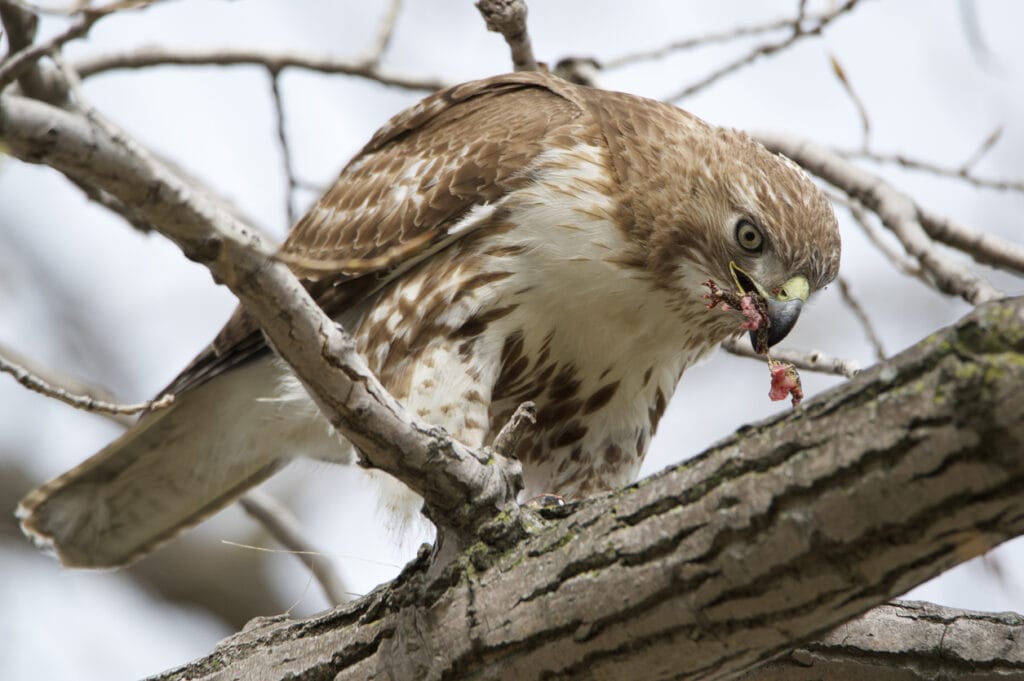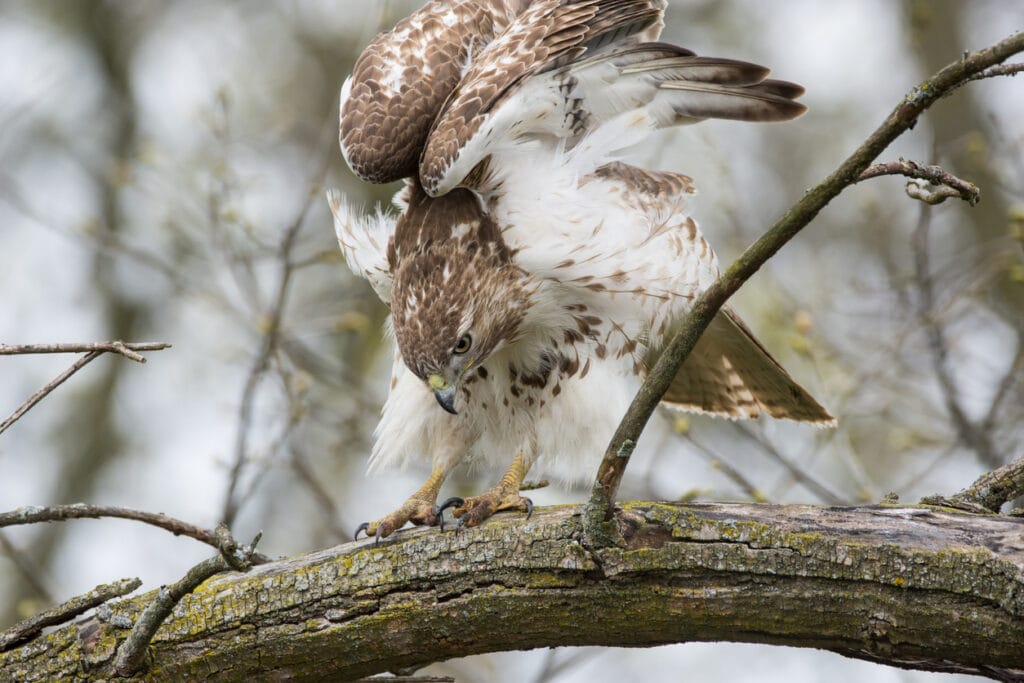Hawks are dangerous, intelligent, and skillful raptors. It’s not hard to see why they’re considered to be one of the sky’s most dominant creatures.
They can live in different environments without any problem, from nesting on top of skyscrapers and utility poles in the city to trees in forests and parks.
These raptors tend to stay within their nests unless it’s time for them to venture out in search of food. What exactly do hawks eat, though? Do hawks eat dead animals? Do they hunt during the day or at night? These are all questions that will be covered in this article, so read on.
Do Hawks Eat Dead Animals?

Hawks are carnivores, meaning they feed primarily on meat. Hawks prefer fresh meat, but there comes a time when resources are scarce. This, in turn, can push hawks to go into a scavenging mode, leading them to eat dead animals and carrions.
Author Note: When in scavenging mode, hawks will eat the dead bodies of animals as easy meals in different forms. These bodies could be from another animal’s discarded hunt, an animal’s death, or even roadkills.
Hawks, while in search of food, can be quite opportunistic, monitoring other predators as they’re conducting their own hunts. As soon as the predator leaves the scene, hawks will swoop in and search for morsels for themselves and their younglings in the nest.
This is often advantageous to hawks, as the morsels will most likely be of animals that hawks wouldn’t be able to attack or hunt on their own.
Some of the predators that hawks monitor include:
Wolves
Wolves are pack animals and hunt as a group, bringing down larger animals so that there would be enough food for the rest of the members of the pack.
There tends to be a lot of meat leftover with wolves, and this opens the opportunity for hawks to come in after the wolves finish eating and grab some meat of their own without exerting energy.
Foxes
Foxes typically catch small prey due to their small stature. A fox’s food sources are pretty much the same as a hawk’s, so the two creatures may end up fighting over these sources.
Alternatively, hawks will follow foxes as they pounce on their meals, and as soon as they leave, the hawks will eat the leftovers.
Adult hawks can sometimes attack the foxes and vice versa. It’s a rare sight, though.
Bears
Bears are large and powerful animals, and thus they either get big kills or tend to fish in nearby rivers or lakes. Either way, hawks can sometimes be seen nearby waiting for the leftovers.
This can be very beneficial to the hawks since bears tend to hunt bigger animals like deers and moose, which hawks wouldn’t be able to take on their own.
That said, bears are omnivores, meaning they can eat just about anything. This can often result in time wasted for hawks, as the bears they’re monitoring might feed on food sources that they don’t eat.
Coyotes
Coyotes are natural scavengers. They have no problems finding rotting animal carcasses and binging on them. Coyotes tend to leave leftovers, though, and that’s where the hawks come in.
As coyotes finish munching on the carrions, hawks will later eat the small pieces of flesh and meat that the coyotes couldn’t get to and take some of it to their nest too.
What Do Hawks Eat?

Hawks’ dietary options are restricted to what’s available in their area. This can change a hawk’s feeding patterns from insects and rodents to medium-sized mammals.
In the City
As cities grew and encroached into forests and other animal territories, hawks assimilated themselves and started living among humans, building nests in skyscrapers and buildings.
Adapting to this new change, they restrict their dietary options according to what’s available in the vicinity. Rats, squirrels, small birds, mice, lizards, and insects, are all on their menu. And if the city is close to the seashore or a river, they will feed on fish when possible.
Hawks can also attack small to medium-sized mammals, which means that, on rare occasions, they might end up attacking a small dog or a cat.
Adult hawks aren’t going to shy away when looking for food and they might resort to attacking younger hawks if food resources are low.
In the Wild
When hawks are in the wild, they have plenty of options available. Essentially, it’s an open buffet for these raptors when they’re in the wild.
Author Note: Insects like crickets, dragonflies, and moths are all excellent sources of protein for hawks. They will also hunt reptiles, including snakes and lizards, if they’re available.
Hawks have small mammals at the top of their menu. Rabbits, hares, rodents, gophers, prairie dogs, and more are at the mercy of these majestic birds of prey.
How Do Hawks Hunt?

Hawks can fly to soaring heights in search of prey. They tend to use different methods to get to their prey, and most of them require precision and speed.
Top Tip: It’s all about sight with hawks, as they rely on it greatly for finding and observing their prey. One of the drawbacks to that is that they’re left vulnerable at night, seeing as they can’t see that well at night.
Here are some of the most common hunting techniques that hawks opt for:
The Perching Method
Hawks will perch in tall trees and mountainsides during the day overlooking their hunting area, waiting for one of their prey to move.
Once their target has been spotted, the hawks will dive at speeds reaching 120 mph with their talons ready to sink into their prey as soon as they reach them.
High Soaring Method
Another technique hawks utilize is ambushing their prey, thanks to their keen sense of sight, as they fly over an open area and keep circling until they find a certain prey.
Once located, they close huge distances by diving down to attack their food source without the prey knowing what hit them.
Low Hovering Method
In a remarkable performance of skill and patience, hawks will fly to a certain hunting ground and hover over one spot where they know there’s prey present.
Using their wings and the air, they will balance themselves and remain in that hovering position until something scurries or slithers below them. That’s when hawks will make their move and pounce on their unsuspecting prey.
While a good tactic, it’s also a dangerous one for the hawk, as it leaves itself open to attacks from other bigger raptors that might be in the area in search of food.
Mid-Air Attacks
Small birds are another target for hawks, especially since these raptors have speed on their side. It’s common to see an aerial pursuit in the sky between a hawk and a smaller bird that’s trying to get away.
Top Tip: Hawks will wear out their prey using flying maneuvers until they catch up and pounce on these unlucky small birds and eat them.
Check out this video showcasing 15 remarkable hawk hunting moments for visual insight.
How Much Do Hawks Need to Eat?

The exact amount that hawks eat varies heavily according to where they are, the kind of species they belong to, and the resources available to them.
That being said, they can eat up to 15% of their body weight daily, but then again, they won’t be able to consistently maintain that intake as there are many variables at play.
One day, hawks can find several smaller prey and get a good meal. On other days, the prey might be hiding well enough that the hawks will need to resort to eating carrions or wait for a fresh meal the following day.
The fact of the matter is, it’s all about survival. In fact, a small percentage of raptors grow up to reach adulthood, and that’s due to several reasons, including hunting, injury, and starvation.
Do Hawks Have to Contend With Other Creatures When Hunting?
Yes, hawks aren’t the only predators or raptors in the sky looking for their next meal, which puts the hawks in danger of being hunted themselves.
On the rare occasion that hawks get attacked, it’s usually due to several factors, which include territorial dispute, the fight over food resources, or falling prey to other more dominant creatures.
Author Note: There are a few animals that put hawks on their menu list. This includes bigger hawks, eagles, snakes, foxes, owls, raccoons, and coyotes.
The bigger hawks, owls, and eagles tend to fight over aerial dominance in an area, and that’s when they could face off and challenge the smaller hawks.
On the other hand, the raccoons and snakes tend to try and attack hawks’ nests to get the eggs while the parents are out in search of food.
In Summary

Do hawks eat dead animals? The answer is yes. Even though hawks prefer fresh meat, they go into a scavenging mode when resources are scarce, which leads them to feed on dead animals.
Hawks will often monitor other predators like wolves, bears, foxes, and coyotes, waiting for them to hunt a prey. Once these predators are done eating, the hawks will swoop in and consume the leftovers.
FAQ
Small mammals are the preferred choice for most hawks.
Hawks will kill any animal that is not too big for them. That includes farmyard animals like chickens but they are not able to kill anything bigger.
Pretty near the top. Only birds as big as eagles would try to take a hawk. Other predators might be wolves or coyotes but they are not likely to be able to catch a hawk.










